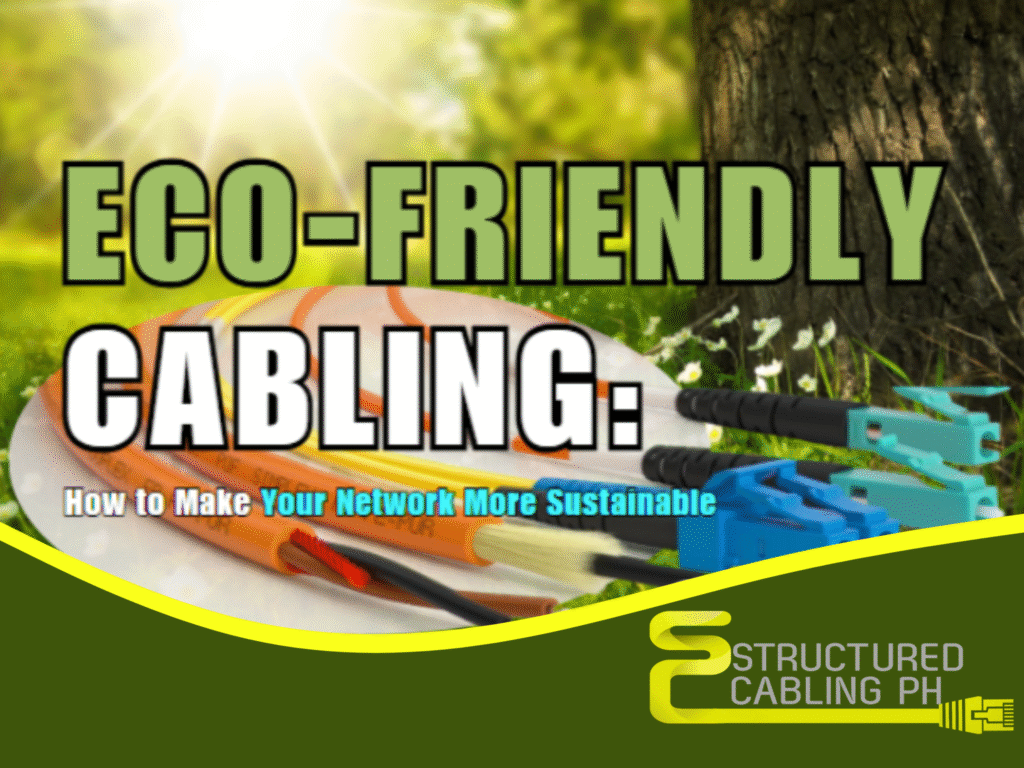
Eco-Friendly Cabling: How to Make Your Network More Sustainable
As businesses and organizations strive to reduce their carbon footprints, sustainability in IT infrastructure is becoming a key priority. One often-overlooked area for improvement is your cabling system. Yes, network cabling can be a part of your green initiative!
Eco-friendly cabling goes beyond just choosing the right materials. It involves designing, installing, and maintaining your structured cabling in a way that minimizes environmental impact while still supporting high performance and reliability.
In this blog, we’ll explore how to make your network more sustainable through smart, responsible cabling choices.
Why Eco-Friendly Cabling Matters
Cabling is the backbone of every network, whether it’s in a commercial office, a data center, or a smart building. However, the materials used in cabling and the energy required to support network operations can have significant environmental consequences if not managed properly.
Key environmental concerns include:
- Use of non-recyclable plastic materials
- Toxic insulation compounds like PVC
- Energy inefficiency in older network systems
- Waste from excessive or poorly managed cabling
Top Ways to Make Your Network Cabling More Eco-Friendly
1. Choose RoHS-Compliant and Low-Smoke Zero Halogen (LSZH) Cables
One of the first steps toward sustainable cabling is selecting materials that are safer for both humans and the environment.
- RoHS-compliant cables (Restriction of Hazardous Substances) are free from heavy metals like lead, mercury, and cadmium.
- LSZH cables emit less smoke and toxic gases during combustion, reducing indoor air pollution and making them safer during fires.
These options also reduce environmental harm during manufacturing and disposal.
2. Invest in High-Quality, Long-Lasting Cabling
Cheaper cables may seem like a cost-saver upfront, but they tend to degrade faster, leading to:
- More frequent replacements
- More e-waste
- Higher long-term costs
High-quality structured cabling, especially fiber optics or shielded copper cables like Cat6a or Cat7, offers better durability and future-proof performance, reducing waste over time.
3. Use Modular and Scalable Cabling Designs
A smart and sustainable cabling layout should be:
- Modular– easily adaptable as needs change
- Scalable– able to handle future bandwidth and power needs
This prevents premature replacements and minimizes material waste when upgrading or expanding your system.
Structured cabling standards like TIA-568 help ensure your network is built with flexibility and longevity in mind.
4. Recycle Old Cables and Reduce Installation Waste
During renovations, upgrades, or decommissions:
- Separate and recycle copper cables and metal connectors
- Dispose of plastic insulation through certified recyclers
- Donate or repurpose usable materials when possible
Also, reduce waste during installation by using only the cable lengths needed and avoiding over-ordering.
5. Opt for Passive Network Infrastructure Where Possible
Reducing reliance on active components (which consume power) can improve sustainability. For example:
- Passive Optical Networks (PONs) use fiber optics with minimal power requirements.
- Passive cable management accessories like trays and organizers reduce the need for powered cooling or monitoring systems.
6. Plan for Energy Efficiency
A well-structured network with optimized cabling reduces:
- Signal loss
- Cooling requirements
- Power consumption from repeaters or amplifiers
Efficient design means fewer resources are needed to maintain high-speed, reliable connectivity.
Sustainability Benefits for Businesses
Implementing eco-friendly cabling practices isn’t just good for the planet, it’s also good for your organization:
- Lower maintenance and energy costs
- Reduced carbon footprint
- Improved ESG (Environmental, Social, Governance) ratings
- Future-proofing for regulations and green certifications (like LEED)
Final Thoughts
As we build smarter, faster, and more connected environments, it’s vital to do so sustainably. Eco-friendly cabling is a practical and impactful way to support your environmental goals while ensuring a robust, high-performance network.
Ready to make your network greener?
VastResult offers sustainable structured cabling solutions using eco-friendly materials and efficient designs. Whether you’re upgrading your office or building a new facility, we can help you align technology with sustainability.
Contact us today at (02) 8404 0740 or email us atsupport@vastresult.com.

